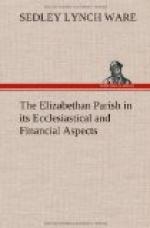[4] 37 Hen. VIII, c. 17, re-enacted I Eliz. c. I. “The real effect of the statute was this—that lay lawyers were substituted for the clerical canonists of pre-Reformation times.” Lewis T. Dibden, An Historical Inquiry into the Status of the Ecclesiastical Courts (1882), 59. By canon cxxvii of the Canons of 1604 in order to be a chancellor, a commissary, or an official in the courts Christian, a man must be “ad minimum magister artium, aut in jure bacalareus, ac in praxi et causis forensibus laudabiliter exercitatus.” E. Cardwell, Synodalia (etc.), i, 236. Cf. Blomefield, Hist. of Norfolk, iii, 655-6 (Parker’s report, 1563. Officials of the archdeacons not required to be in orders). E. Cardwell, Documentary Annals of the Reformed Church of England, i, 426 (Complaint in a document of circa 1584 [or later] that excommunication is executed by laymen. In the answer by the bishops it is stated [ibid., 428] inter alia, “that in later times, divines have wholly employed themselves to divinity and not to the proceedings and study of the law"). To the same effect, but for a later period, see White Kennett, Parochial Antiquities (Oxon. ed. 1695), 642.
[5] Harrison, writing in 1577, says that archdeacons keep, beside two visitations or synods yearly, “their ordinarie courts which are holden within so manie or more of their several deaneries by themselues or their officials once in a moneth at the least.” Harrison, Description of England, Bk. ii, New Shakespeare Soc. for 1877 (ed. Dr. Furnivall), p. 17. Between 27th Nov., 1639, and 28th Nov., 1640, there were thirty sittings in the court of the Archdeacon of London. Hale, Crim. Prec., introd. p. liii. Any casual inspection of the visitation act-books reveals the fact that the judge sits either in court or in chambers between visitations, for offenders are constantly ordered to appear again in a few days or in a few weeks. Compulsory presentments were, however, limited by law and custom to two courts a year. See canons 116 and 117 of the Canons of 1604. Also Gibson, Codex, ii, 1001.
[6] See p. 18 and p. 20 infra. For the duty to read the injunctions or the articles based on them see p. 32 infra.
[7] See 5 Eliz. c. 3. Stats. of the Realm, iv, Pt. i, 411. Also Visitation of Warrington Deanery in 1592 by the Bishop of Chester in Lancashire and Cheshire Historic Soc. Trans., n. s., x (1895), 186 et passim. Hereinafter cited as Warrington Deanery Visit. Cf. also Grindal’s Injunc. for the Province of York (1571), art. 17, Remains of Grindal, Parker Soc., 132 ff.
[8] See Visitations of the Archdeacon of Canterbury, Archaeologia Cantiana, xxvi (1904), 24 (1602). Mr. Arthur Hussey has published copious extracts from the act-books of these visitations extending over a considerable period in vols. xxv-xxvii of the Arch. Cant. Hereinafter cited as Canterbury Visit., xxv (etc.). For perambulations see p. 27 infra.




